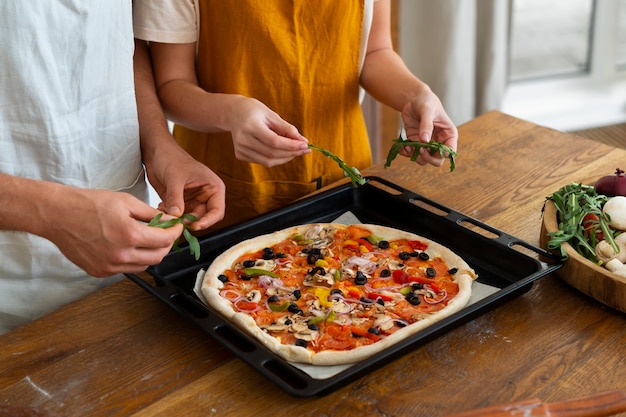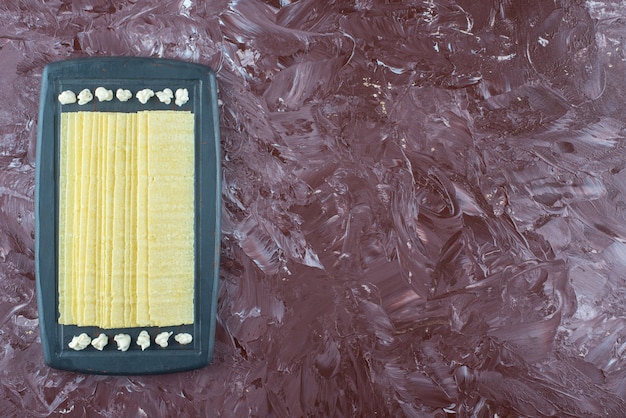Lasagna. Just the word conjures up images of bubbling cheese, rich sauce, and perfectly cooked pasta layers, all nestled in a warm, inviting baking dish. It’s a dish that embodies comfort and joy, a quintessential family favourite that brings people together. But let’s be honest, there’s always that moment of uncertainty when you’re staring at the oven timer, wondering: "How long do I bake this thing?" It’s a question that has plagued even the most experienced cooks, leading to anxieties about soggy pasta or a burnt crust.
Well, fret no more, fellow lasagna lovers! I'm here to demystify the art of baking lasagna, taking you from kitchen novice to confident lasagna maestro. Over the years, I've learned the secrets to a perfectly baked lasagna, and I'm ready to share them with you, from understanding the crucial factors that influence baking time to mastering the telltale signs of doneness. Buckle up, grab your favourite apron, and let's dive into the world of lasagna baking!
(Part 1) The Science Behind Baking Time

Unveiling the Importance of Baking Time
Baking time is more than just a random number on a recipe. It's the key to unlocking a symphony of flavours and textures in your lasagna. It's the time it takes for magic to happen in the oven, transforming individual ingredients into a cohesive, harmonious dish.
Imagine, for a moment, biting into a lasagna where the cheese is still cold and rubbery, the sauce watery and bland, and the pasta stubbornly clinging to your teeth. Not exactly the culinary experience you're aiming for, right? Baking time is what ensures the cheese melts into a bubbly, golden delight, the sauce simmers into a velvety richness, and the pasta softens to a perfect al dente texture. It's the secret to a lasagna that melts in your mouth, leaving you craving for more.
Factors that Dictate Baking Time
There's no single magic number that dictates the perfect baking time for your lasagna. Instead, it's a delicate dance influenced by several factors that need to be carefully considered. Think of them as the ingredients that go into your baking time recipe:
- The Size and Shape of Your Baking Dish: A large, shallow baking dish will allow for faster heat distribution, potentially leading to a shorter baking time. Conversely, a smaller, deeper dish might require a bit more time to cook the lasagna evenly.
- The Type of lasagna noodles: No-cook noodles are a time-saver, often requiring less baking time than traditional dried noodles. This is because they're already pre-cooked and only need to be heated through.
- The Amount of Sauce and Cheese: More sauce and cheese mean more time needed for the cheese to melt and the sauce to thicken. It's like adding extra ingredients to your baking recipe, demanding a longer cooking time.
- Your Oven's Temperament: Every oven has its own personality, some running hotter, others cooler than their set temperature. If your oven runs hot, you might need to reduce the baking time slightly. If it runs cool, you might need to add a few extra minutes.
- The Thickness of Your lasagna layers: A thick lasagna with multiple layers will naturally need more time to bake through compared to a thinner, more streamlined lasagna. It's like having a thicker dough in a bread recipe, requiring longer baking.
General Baking Time Guidelines: A Starting Point
While every lasagna is unique, there are some general baking time guidelines that can serve as a helpful starting point:
| Lasagna Type | Baking Time |
|---|---|
| Traditional Lasagna with Dried Noodles | 30-45 minutes |
| Lasagna with No-Cook Noodles | 25-35 minutes |
Remember, these are just estimations. You're the conductor of your lasagna symphony, and you'll need to adjust the baking time based on the specific ingredients and the personality of your oven. Start with the shorter end of the baking time range and check for doneness frequently. Patience is key, and it will reward you with a perfectly baked masterpiece.
(Part 2) Mastering the Art of Checking Doneness

Visual Clues that Signify Lasagna Perfection
You'll know your lasagna is ready when it sings with a chorus of visual cues, a sign that all the ingredients have come together in perfect harmony. Here's what to look for:
- Bubbly, Golden Cheese: The cheese on top should be a beautiful golden brown, adorned with charming air bubbles. This is the hallmark of melted, perfectly cooked cheese, adding a delightful textural element to your lasagna.
- Thickened, Bubbling Sauce: The sauce should have thickened considerably, coating the pasta layers generously. You'll notice it bubbling around the edges of the lasagna, a sign that it's simmered to perfection.
- Tender, Soft Pasta: The pasta should have softened to a delightful al dente texture, offering a slight resistance while still being tender and easy to eat.
The "Fork Test": A Time-Honoured Tradition
The fork test is a classic lasagna check-up, a ritual that every lasagna baker must perform. Carefully insert a fork into the center of the lasagna. If it slides in effortlessly and the pasta feels tender, your lasagna is ready to be enjoyed. However, if the fork encounters resistance, and the pasta feels firm, give your lasagna a few more minutes in the oven.
Beware of Overbaking: A Culinary Faux Pas
It's easy to fall into the trap of overbaking, thinking that it will ensure your lasagna is cooked through. But resist this temptation! Overbaking can lead to a dry, cardboard-like pasta, and the sauce will thicken to the point of being gluey, ruining the delicate balance of flavours and textures. Be patient, check for doneness frequently, and celebrate the moment your lasagna reaches its peak of perfection.
(Part 3) Troubleshooting: Tackling Lasagna Baking Challenges

Even the most seasoned bakers can encounter a few bumps in the road when baking lasagna. But fear not, every challenge has a solution. Let's explore some common lasagna baking issues and how to overcome them:
My Lasagna Isn't Baking Evenly: A Tale of Uneven Heat
If your lasagna seems to be cooking unevenly, it might be a sign that your oven is not distributing heat evenly. This can be remedied by using a simple baking sheet as a heat diffuser. Place a baking sheet on the rack below your lasagna. This will help distribute heat more evenly, ensuring your lasagna bakes to golden perfection.
My Lasagna Is Burning: A Case of Overzealous Heat
A burning lasagna is a clear sign that it's spending too much time in the oven. Lower the oven temperature by 25 degrees Fahrenheit (about 14 degrees Celsius) and continue baking until the lasagna reaches its desired state of doneness.
My Lasagna Is Soggy: A Battle Against Moisture
A soggy lasagna is a culinary tragedy, a dish that loses its structure and becomes a sad, watery mess. There are a few common culprits that can lead to this unfortunate outcome:
- Overcrowding the Baking Dish: If your lasagna pan is overflowing with layers, the steam generated during baking has nowhere to escape, leading to a soggy dish. Make sure you leave adequate space between the lasagna and the edges of the pan.
- Pasta Not Cooked Through: If your pasta is still chewy, it won't absorb the sauce properly, resulting in a soggy mess. Ensure your pasta is fully cooked before assembling the lasagna.
- No-Cook Noodles Need TLC: If you're using no-cook noodles, make sure they're completely thawed and not overly wet before assembling your lasagna.
(Part 4) Tips and Tricks: Elevating Your Lasagna Game
Now that you have a solid understanding of the basics, let's elevate your lasagna baking game with some helpful tips and tricks. These are the secrets that separate good lasagna from legendary lasagna:
Use a High-Quality Baking Dish: A Foundation for Success
Your choice of baking dish is not just about aesthetics. A high-quality dish made of glass, ceramic, or metal will distribute heat evenly, ensuring your lasagna bakes perfectly. Avoid using a dish with a loose bottom as it can lead to a soggy lasagna.
Don't Overfill the Dish: Give the Lasagna Room to Breathe
Overcrowding your baking dish can prevent the sauce from bubbling and thickening properly. Ensure you leave some space between the lasagna and the edges of the dish, allowing the sauce to simmer and the cheese to melt to their full potential.
Layer by Layer: The Key to Perfectly Cooked Pasta
Each layer of pasta needs to be fully cooked and absorb the sauce. So, make sure to spread a thin layer of sauce between each layer of pasta. This will ensure a delicious, even texture throughout your lasagna.
Embrace the Power of Foil: The Secret to a Perfectly Cooked Crust
Cover your lasagna with foil for the first part of the baking time. This helps the pasta cook evenly and prevents the cheese from burning. After the first 30 minutes of baking, remove the foil to allow the cheese to brown and bubble, adding a delightful golden hue to your lasagna.
Rest is a Virtue: Let Your Lasagna Cool Down
Once your lasagna emerges from the oven, resist the temptation to dive in right away. Let it rest for at least 15 minutes before serving. This allows the lasagna to set and the flavours to meld, creating a more cohesive and delicious dish.
(Part 5) Exploring Lasagna Styles: A culinary adventure
Lasagna is a wonderfully versatile dish, open to endless possibilities. Let's explore some variations that will tickle your taste buds and broaden your culinary horizons:
Traditional Italian Lasagna: A Classic for a Reason
This is the lasagna that started it all, the foundation upon which all other lasagna styles are built. It features layers of pasta, rich bolognese sauce, creamy béchamel sauce, and ricotta cheese, creating a symphony of flavours and textures that will leave you satisfied and wanting more.
vegetarian lasagna: A Plant-Based Delight
This version of lasagna puts the spotlight on vegetables, substituting meat for a hearty, flavorful veggie sauce. It's a delicious and healthy option for vegetarians and meat-lovers alike, showcasing the beauty of plant-based ingredients.
Spinach and Ricotta Lasagna: A Lighter Option
This lighter version features a blend of spinach and ricotta cheese, offering a fresh and vibrant alternative to the classic lasagna. It's a fantastic choice for a weeknight dinner or a casual gathering, providing a lighter and more refreshing experience.
Lasagna Roll-Ups: A Fun and Unique Twist
This version is a delightful twist on the traditional lasagna. Instead of layering the pasta, you roll up the lasagna into individual tubes, creating bite-sized portions that are easy to eat and visually appealing.
(Part 6) My Personal lasagna recipe: A Tried-and-True Favourite
I've been perfecting my lasagna recipe for years, and it's become a family favourite. Here's the recipe that has won over hearts and stomachs alike:
Ingredients
- 1 pound lasagna noodles
- 1 jar (28 ounces) marinara sauce
- 1 pound ground beef
- 1 onion, chopped
- 2 cloves garlic, minced
- 1 (15-ounce) container ricotta cheese
- 1 cup shredded mozzarella cheese
- 1/2 cup shredded Parmesan cheese
- 1/4 cup chopped fresh basil
- 1 teaspoon dried oregano
- 1/2 teaspoon salt
- 1/4 teaspoon black pepper
Instructions
- Preheat oven to 375 degrees Fahrenheit (190 degrees Celsius).
- In a large skillet, brown the ground beef over medium heat. Drain off any excess grease.
- Add the onion and garlic to the skillet and cook until softened, about 5 minutes.
- Stir in the marinara sauce, oregano, salt, and pepper. Bring to a simmer.
- In a large bowl, combine the ricotta cheese, mozzarella cheese, Parmesan cheese, and basil.
- Spread a thin layer of sauce in the bottom of a 9x13 inch baking dish.
- Top with 3 lasagna noodles, overlapping them slightly.
- Spread a layer of the ricotta cheese mixture over the noodles.
- Top with another layer of sauce.
- Repeat layers 2-4, ending with a layer of sauce.
- Sprinkle with the remaining mozzarella cheese.
- Cover the baking dish with foil and bake for 30 minutes.
- Remove foil and bake for an additional 15-20 minutes, or until the cheese is melted and bubbly and the pasta is cooked through.
- Let the lasagna rest for 15 minutes before serving.
(Part 7) Beyond the Basics: Unlocking Flavour Potential
The beauty of lasagna lies in its adaptability. Let's explore some flavour variations that will take your lasagna from delicious to extraordinary:
A Touch of Spice: Adding Heat and Depth
Spice up your lasagna with a sprinkle of red pepper flakes or a dollop of hot sauce. This adds a kick of heat that will tantalize your taste buds, adding a vibrant element to your culinary creation.
Vegetable Harmony: A Symphony of Freshness
Don't limit yourself to traditional ingredients. Experiment with different vegetables like mushrooms, peppers, zucchini, or eggplant. These additions provide bursts of flavour and texture, adding a touch of freshness to your lasagna.
The Power of Spinach: A Nutritional Boost
Layer a handful of spinach between the pasta and sauce. It adds a vibrant green colour and a boost of nutrients, enriching your lasagna while adding a subtle flavour element.
Cheese Exploration: A Journey of Taste
Beyond the classic mozzarella and ricotta, venture into the world of cheeses. Experiment with provolone, asiago, or even goat cheese. Each cheese brings its unique flavour and texture, creating a new dimension of taste in your lasagna.
(Part 8) FAQs: Clearing Up Lasagna Mysteries
Q: Can I freeze lasagna?
A: Yes, you can freeze lasagna! For optimal results, freeze it unbaked. Assemble the lasagna in your baking dish, cover it tightly with foil, and freeze for up to 3 months. To bake from frozen, thaw it overnight in the refrigerator and then bake as directed, adding an extra 15-20 minutes to the baking time.
Q: What happens if I overbake my lasagna?
A: Overbaking lasagna can lead to a dry, crunchy dish. The pasta will become hard and the sauce will thicken excessively, ruining the delicate balance of textures and flavours.
Q: Can I use pre-made lasagna sauce?
A: Absolutely! Using pre-made lasagna sauce is a convenient option, and it's often very tasty. However, if you're making your own sauce, remember to simmer it for a while to allow the flavours to meld and deepen.
Q: How do I know if the pasta is cooked through?
A: Use the trusty fork test! Insert a fork into the center of the lasagna. If the pasta slides easily onto the fork, it's cooked through. If it's still firm, it needs a few more minutes in the oven.
Q: Can I substitute the ricotta cheese with another type of cheese?
A: While ricotta cheese is a classic lasagna ingredient, you can certainly substitute it with other cheeses. Cottage cheese, mascarpone cheese, or even cream cheese can work as substitutes. Adjust the amount of cheese according to the texture and flavour of your chosen substitute.
So, there you have it, the complete guide to baking lasagna, from understanding the fundamentals of baking time to mastering the art of checking for doneness and exploring flavour variations. Embrace your inner lasagna master and create a dish that will leave everyone wanting more. Happy baking!
Everyone is watching

Prime Rib Roast Cooking Time Chart: Per Pound Guide
Cooking TipsPrime rib roast. Just the name conjures images of lavish dinners, crackling fires, and hearty laughter. It’s ...

How Long to Bake Potatoes in the Oven (Perfect Every Time)
Cooking TipsBaked potatoes are a staple in my kitchen. They're incredibly versatile, delicious, and surprisingly easy to m...

Perfect Rice Every Time: The Ultimate Guide to Cooking Rice
Cooking TipsAs a self-proclaimed foodie, I've always been a bit obsessed with rice. It's the foundation of countless cuisi...

The Ultimate Guide to Cooking Asparagus: Tips, Techniques, and Recipes
Cooking TipsAsparagus. The mere mention of this spring delicacy conjures up images of vibrant green spears, crisp and burs...

Ultimate Guide to Cooking the Perfect Thanksgiving Turkey
Cooking TipsThanksgiving. Just the word conjures up images of overflowing tables laden with delicious food, the scent of r...
